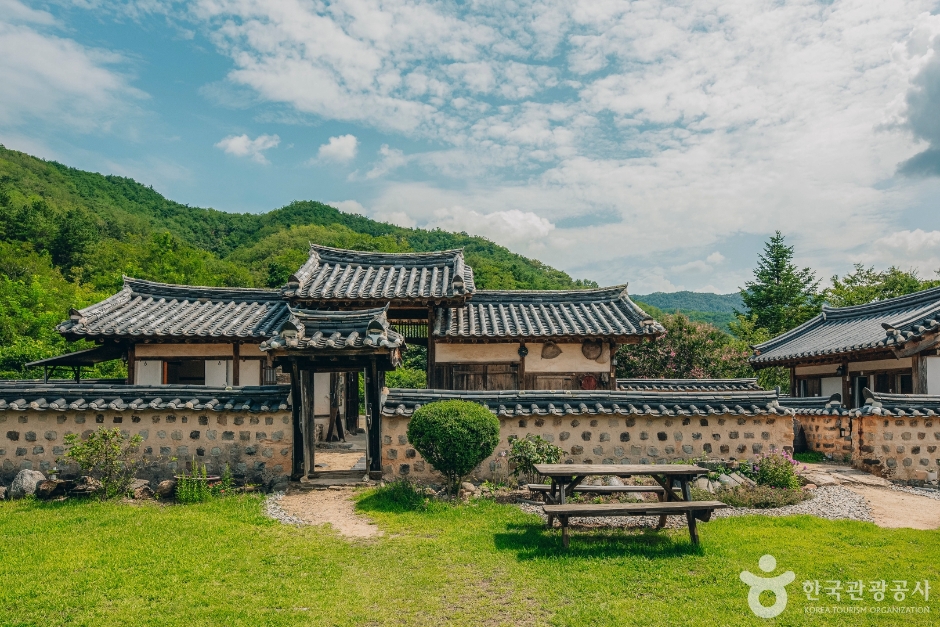Jeolgolgyegok Valley [National Geopark] (절골협곡 (청송 국가지질공원))
15.1Km 2025-01-14
San 124, Jusanji-ri, Cheongsong-gun, Gyeongsangbuk-do
+82-54-870-6111
Jeolgolgyegok Valley is located along the mountain ridgeline connecting Gamebong Peak and Wanggeoam Rock in Juwangsan Mountain. It stretches for 5 kilometers from Jeolgol Valley Visitor's Center to Daemun Bridge. The valley is formed of vocanic tuffs that were welded and compacted after cooling down, which resulted in forming vertical cracks, leaving rocks to fall out and create a steep valley cliff.
Jusanji Pond [National Geopark] (주산지 (청송 국가지질공원))
17.1Km 2025-03-15
Jusanji-ri, Cheongsong-gun, Gyeongsangbuk-do
+82-54-870-6111
Jusanji Pond is a small reservoir located in Juwangsan National Park. It is a man-made pond that was dug out in August, 1720 and completed in October the year after. The pond has been used as a source of water for agricultural use as well as for drinking water. Even though it is small in size, about 200 meters long and 8 meters deep, the pond has never dried up from any drought.
150-year-old willow trees are rooted in the pond, which makes a fantastic balance with the surroundings, creating a picturesque scenery found nowhere else.
Suaedang (안동 수애당)
18.2Km 2024-12-20
1714-11 , Sugogyonggye-ro, Andong-si, Gyeongsangbuk-do
+82-54-822-6661
Suaedang House in Andong, Gyeongsangbuk-do, was built in 1939 by independence activist Soo Ae Yu Jin-geol, and is a Gyeongsangbuk-do cultural asset. The hipped-and-gabled pavilion and the ㄱ-shaped gobangchae (female servants’ quarters) face each other across the courtyard, and the house has a 10-metre lofty gate. Suaedang was moved to its current location in 1987 due to the construction of the Imha Dam. The room and Daecheongmaru are red clay-walled and natural painted. The view of the lake from Suaecang is very beautiful.
Yeomyeong Humanities Healing Center (인문힐링센터여명)
18.9Km 2025-10-23
203 , Jangyuksa 1-gil, Yeongdeok-gun, Gyeongsangbuk-do
The Yeomyeong Humanities Healing Center is a hanok (traditional Korean house) facility nestled in the beautiful nature of Yeongdeok. The center aims to become a popular healing and meditation spot for wellness tourists. It features mind-healing programs, including mind training, meditation, ki (energy) exercise, and health food experiences for today's world where people are under a lot of stress. Experts from different fields help visitors maintain healthy minds and bodies through systemic programs, in response to growing demands for wellness tourism.
Jeongjae Head House (정재종택)
19.0Km 2024-12-20
2661-8 , Gyeongdong-ro, Andong-si, Gyeongsangbuk-do
+82-54-822-6205
Jeongjae Head House is the head house of Joseon scholar Jeongjae Ryu Chi-myeong, a colleague of the famous Toegye Lee Hwang. The house overlooks Imha Lake in Andong-si, Gyeongsangbuk-do, and is 300 years old. The long endurance of the stone foundations, roof tiles and wooden beams and porch gives the place a solid, calming feel. The house consists of a daemunchae (gate house) jeongchim (square-shaped building), haengnangchae (servants’ quarters), sadang or shrine, and a pavilion called Manujeong which houses a lecture hall but can also be used for lodging. Guests can learn how to brew songhwaju spirit and tarak fermented milk liquor, and listen to gayageum or folk song performances.

![Jusanji Pond [National Geopark] (주산지 (청송 국가지질공원))](http://tong.visitkorea.or.kr/cms/resource/84/2616884_image2_1.jpg)


 English
English
 한국어
한국어 日本語
日本語 中文(简体)
中文(简体) Deutsch
Deutsch Français
Français Español
Español Русский
Русский